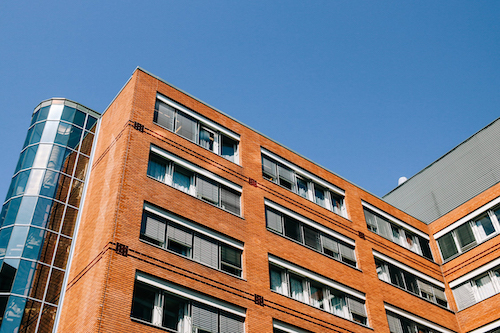Choosing the right exterior finishing for a commercial building is essential for protecting the building and attracting buyers, tenants, and customers. All too often, deciding between exterior wall finishes for commercial buildings can lead to sacrificing longevity and aesthetic appeal for cost.
At ClarkDietrich, we don’t see cost-effectiveness and functionality that looks good as an either-or decision. In this article, we break down some of the key differences between exterior finishing materials for commercial buildings, and how investing in more durable materials up-front can yield impressive savings over time.

What Are Most Building Walls Made Of?
Most commercial building walls are built around a steel structure with several subsequent layers that manage air and water exposure, as well as thermal and vapor layers. In commercial construction, concrete is the most common choice for finishing exterior walls. Why? Because concrete is:
- Resistant to fire, sound, weather, and even vermin
- Resilient to cracking
- Easy to mold to different building designs
- Low-maintenance
What Are Most Office Walls Made Of?
Office buildings follow the conventions of most commercial units and often use concrete finishing on exterior walls. For these buildings, functionality often takes priority over aesthetics, and builders can be willing to trade looks for walls that hold up against the elements.
What Are Types of Walls in Apartments?
Apartments see a wider variety of finishing materials than office buildings. Tenants tend to be pickier when choosing how their home will look than their office, so builders need to balance functionality with aesthetics. To appeal visually to more renters, apartment buildings make more use of materials like brick and manufactured stone veneer when finishing exterior walls.
What Material Is Used for Exterior Walls?
While concrete is a popular choice for finishing exterior walls, stucco, fiber cement, vinyl, brick, metal, and manufactured stone veneer can also be excellent materials. When evaluating materials used in commercial buildings, it’s important to consider their:
- Functionality: How durable is the material and for how long? What climates is the material suited for, and which environments cause damage?
- Aesthetics: Does the material enhance the appeal of the building? Will it appropriately represent the building’s use?
- Cost: What’s the cost per square foot to install the material? Are there any products that can extend the life of the material?
Stucco
Stucco can fit a variety of aesthetic styles on both flat and curved surfaces. This material can also last for 100 years, offering durability alongside visual appeal. Stucco also tends to be a budget-friendly material. However, stucco can be difficult to install properly, which may lead to increased installation costs and a higher risk of issues down the road, if not completed properly.
Fiber Cement
Fiber cement—constructed from a combination of cement, sand, and cellulose fibers—offers many of the same functional benefits as concrete, such as fire- and rot-resistance. Aesthetically, fiber cement’s colors tend to last for several years while needing minimal maintenance and upkeep. Like stucco, fiber cement also requires great care during installation, otherwise, the finishing could crack and expose the building to costly water damage.
Vinyl
Vinyl can be one of the most budget-friendly options when finishing exterior commercial walls. However, this siding is often associated with residential buildings, and in a commercial setting, it’s typically used for apartments. Vinyl does have some functional benefits, such as adding a waterproof layer, but it has difficulty withstanding extreme temperatures. This material tends to warp under high heat and crack from cold temperatures.
Brick
Brick walls require some of the highest up-front costs, but can also last for hundreds of years, which cuts down significantly on replacement costs. Builders also have the option of brick veneer to add a thin sheet of brick over an existing wood wall.
Metal
Metal finishing stands up to the elements, from extreme heat and cold to harsh winds. Metal finishing comes in a variety of colors and thicknesses to fit specific projects, making it a durable and versatile choice. However, metal does come at a steeper cost than many other materials. You can get the most from your investment with exterior wall coating, which extends the life of metal finishing and helps reduce wear and leaks.
Manufactured Stone Veneer
Real stone can be an appealing aesthetic choice, but it is often cost-prohibitive. Manufactured stone veneer offers a nearly identical look at a fraction of the cost of real stone. Manufactured stone veneer also offers functionality, lasting 20 to 75 years with proper upkeep.
COMMERCIAL WALL CONSTRUCTION THAT LASTS
Aesthetic preferences vary depending on buyers and the building’s intended use. Functionality needs are different depending on the climate the building will be up against. One thing that needs to stay consistent across all commercial construction is getting the job done right the first time. Without proper installation, exterior walls can fail to keep the elements out, leading to costly damages and unsightly properties.
At ClarkDietrich, our goal is to provide premium products that enable builders to install exterior walls that last. We understand that expert help can be hard to find, so our products are designed for even the newest of team members to use successfully.
Ready to see the difference that quality products can make? Explore our exterior finishing solutions, such as our Easy Embedment System™ (EES).